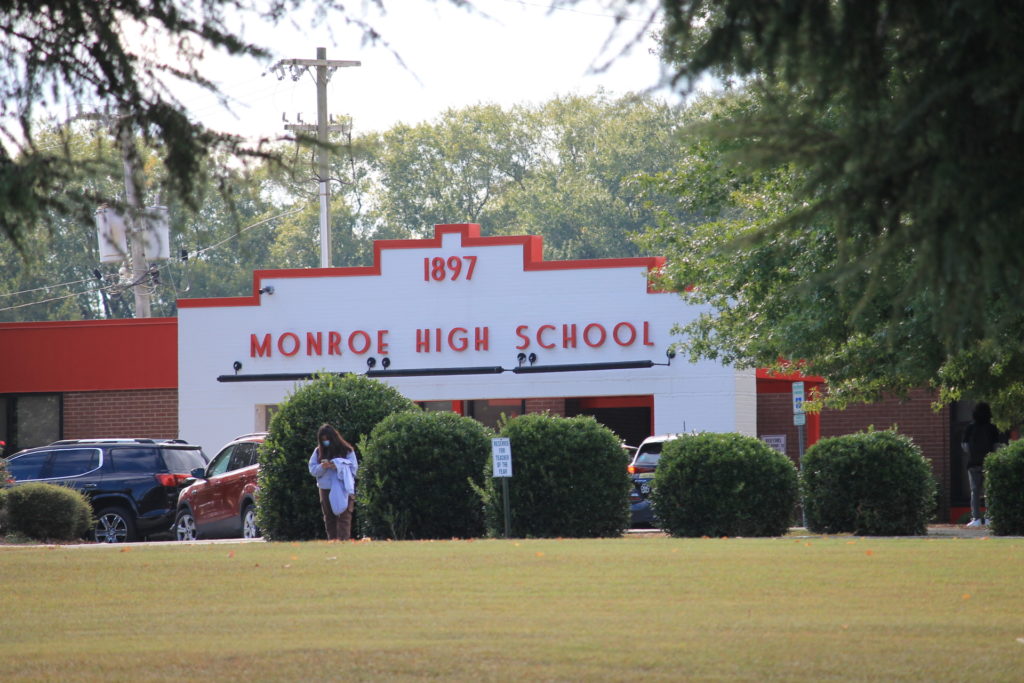After a year of holding classes on Zoom, schools across the country have returned to in-person learning this fall.
In the latest episode of A Better Life?, Producer Katelynn Laws visits the rural town of Monroe, North Carolina, a community with a large Latino population, to learn how students are making up for what many say was a lost year.
At Monroe High, the school year is in full swing. Classes let out at 3:05 pm, and waves of students stream out of the school — many heading towards buses, or the car ride line that reaches the end of the block. A lot of students are wearing masks, but not all of them.
Monroe, North Carolina is the county seat of Union County. The county has some suburban areas to the west but is otherwise largely rural. It’s also overwhelmingly white — over 80 percent of the population. But unlike the rest of the county, Monroe has a sizable Latino community.
The student body at Monroe High is 59 percent Latino and 29 percent Black. Across North Carolina, Latinos and Blacks have been particularly hard hit by the pandemic.
Latinos make up about a tenth of North Carolina’s total population, but last summer they accounted for almost half of all Covid cases in the state. Part of this is because industries that employ a significant number of Black and Latino people, such as meat processing plants, couldn’t maintain the recommended distance between workers. In North Carolina, clusters at meat and poultry plants account for over 5,000 Covid cases.
Monroe High is just a 5-minute drive from a chicken processing plant.
When parents get Covid, it often has serious consequences for their children who are in school. “My mom had gotten Covid and she couldn’t work for a while,” said Victor, a senior at Monroe High who had to quit school last year to help support his family. “ I wasn’t able to go to school,” Victor said. “I had to work to pay the bills at home, basically.”
Stories like Victor’s are troubling to Ricky Hurtado. He is a member of the North Carolina House of Representatives and the co-founder of LatinxEd, an organization that supports Latino students striving for higher education.
“North Carolina is not equipped right now, in our public schools, to deal with the mental health crisis that is currently happening among our students. Especially among Latinx students who are seeing their families disproportionately impacted by Covid-19,” Hurtado said.
The 2020 school year, when most in-person classes were canceled, widened the educational gap separating Latino and Black kids from their White counterparts, according to a study by McKinsey and Co. The pandemic put Latinos behind by six months in math and five months behind in reading, compared to a lag of about four and three months for White students. The number of Latino students headed to college, which was on the rise before the pandemic, dropped dramatically for Latinos — more than any other group.
These disparities can lead to serious problems for students later in life.
“If you’re already behind in some of the fundamental skill sets, and then you get pushed further behind, it’s hard to understand how one could sustain a living for themselves,” said James Ford a member of the North Carolina State Board of Education.
“How they can raise a family. How they can be in communities where there aren’t rampant social problems due to the lack of resources that are really rooted in those problems?” asks Ford who co-founded the Center for Racial Equity in Education.
For many students, the return to in-person learning has made a huge difference. “My parents are, like, super happy that we’re back in school,” said Victor. “I mean, me and my brother’s grades are all going up and stuff. So, they’re really happy about that.”
But Covid continues to pose significant risks. Out of 115 school districts in North Carolina, Union County is one of only five that don’t require masks in school. As a result, students who are unaware they have Covid can come to school maskless and put others at risk. According to the North Carolina Department of Health, Union County is considered a high Covid transmission area.
“I mean, the first day [of school] they tried to send me home,” said Erika, a junior at Monroe High. “But they already sent 15 kids home the same first day. Second day is more and more, ‘cause people are not wearing their masks.” Three weeks into the school year, over 7000 students and staff were in quarantine, and almost 500 people tested positive for Covid.
On Monday, September 13th, the Union County Board of Education voted 8-1 to stop quarantining and contact tracing for students who weren’t showing symptoms but were potentially exposed to Covid. The decision to stop proactive Covid procedures brought the school district in violation of state law. When the North Carolina Department of Health threatened to take legal action, the school board reinstated quarantining and contact tracing policies.
To state Board of Education member James Ford, the response to Covid by schools across North Carolina has disturbing echoes of inequities that existed before the pandemic. “I really see [this school year] culminating in a school system that really returns, like a rubber band, sort of, back to form in a really violent way that ends up popping a lot of our kids and leaving them with few educational prospects,” he said.
Feet in 2 Worlds is supported by The Ford Foundation, the David and Katherine Moore Family Foundation, an anonymous donor and readers like you.




